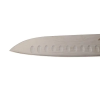OK newbie grade question time!
Some one was telling me my Ka-Bar 1211 was "Stronger" because of the (I'll call it the Fuller and not the "BLOOD GROOVE" some one insisted on calling it) Fuller gives the I-Beam extra strength vs, my OKC 499M non fuller blade. (its a great beater blade and tough as heck, some one wanted it to Mod it down to some weird shape because it has all that steel to play with, the non sharpened swedge lets me take it out where I live like the Ka-bars I got). Yes I know alloys make them slightly different critters.
From what I understandishly know, is the Fuller fulfills the act of strengthening out the blade as its thinned out to make it lighter and use less material while keeping the performance of a thicker heavier blade...sort ofishly. It all made me wonder again what is more rightishly along those lines.
I figured the experted people here can explain it better than I can think it.
Thanks in advance for answering this newbie grade question.
Some one was telling me my Ka-Bar 1211 was "Stronger" because of the (I'll call it the Fuller and not the "BLOOD GROOVE" some one insisted on calling it) Fuller gives the I-Beam extra strength vs, my OKC 499M non fuller blade. (its a great beater blade and tough as heck, some one wanted it to Mod it down to some weird shape because it has all that steel to play with, the non sharpened swedge lets me take it out where I live like the Ka-bars I got). Yes I know alloys make them slightly different critters.
From what I understandishly know, is the Fuller fulfills the act of strengthening out the blade as its thinned out to make it lighter and use less material while keeping the performance of a thicker heavier blade...sort ofishly. It all made me wonder again what is more rightishly along those lines.
I figured the experted people here can explain it better than I can think it.
Thanks in advance for answering this newbie grade question.






